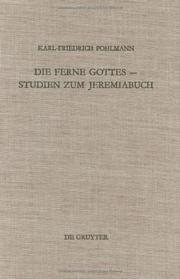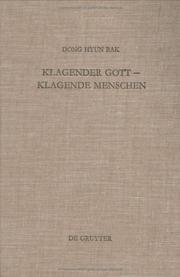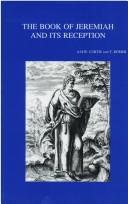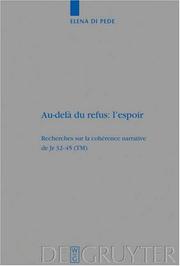| Listing 1 - 10 of 30 | << page >> |
Sort by
|
Book
ISBN: 9004269657 9789004269651 1306771951 9781306771955 9789004269644 9004269649 Year: 2014 Publisher: Leiden BRILL
Abstract | Keywords | Export | Availability | Bookmark
 Loading...
Loading...Choose an application
- Reference Manager
- EndNote
- RefWorks (Direct export to RefWorks)
In Ancient Hebrew Periodization and the Language of the Book of Jeremiah , Aaron Hornkohl defends the diachronic approach to Biblical Hebrew and the linguistic dating of biblical texts. Applying the standard methodologies to the Masoretic version of the biblical book of Jeremiah, he seeks to date the work on the basis of its linguistic profile, determining that, though composite, Jeremiah is likely a product of the transitional time between the First and Second Temple Periods. Hornkohl also contributes to unraveling Jeremiah’s complicated literary development, arguing on the basis of language that its 'short edition', as reflected in the book’s Old Greek translation, predates that 'supplementary material' preserved in the Masoretic edition but unparalleled in the Greek. Nevertheless, he concludes that neither is written in Late Biblical Hebrew proper.
Book
ISBN: 311054069X 9783110540697 9783110542721 9783110543377 Year: 2017 Volume: 506 Publisher: Berlin ; Boston Walter de Gruyter GmbH
Abstract | Keywords | Export | Availability | Bookmark
 Loading...
Loading...Choose an application
- Reference Manager
- EndNote
- RefWorks (Direct export to RefWorks)
The oldest parts of the Book of Jeremiah, that according to K.-F. Pohlmann (1978), C. Levin (1985), K. Schmid (1996) and others can be found in Jeremiah 4-6, 8-10, complain of the devastation of the country by an enemy coming from the north. However, they do not name the name Jeremiah, nor can they be called "prophetic" in the ancient Near Eastern sense. In this aspect, the lamentations in Jeremiah 4: 19-22; 6.9 to 15; 8.18 to 23; 10,19-25 are subjected to a historical-critical examination and to a comprehensive comparison with the ancient Near Eastern literature of kalu. The results of the comparative study as well as the findings on the non-Biblical, ancient Near Eastern relationship of lament and prophetic literature present a new perspective on the genesis of the Jeremiah book. Because the core of the book is based on cultic complaints, lines of editorial history can be drawn on the one hand into Jeremiah's court prophecy and on the other hand into the further development of the lamentation theme up to the so-called "confessions." Further, the texts examined in Jeremiah 4-6; 8-10; 7; 11; 14-15 offer new conclusions about the representation of the literary Jeremiah as an intercessor and court prophet.
Intercessory prayer --- Laments in the Bible --- 224.3 --- 224.3 Jeremias. Lamentationes. Klaagliederen --- 224.3 Jeremie. Lamentations de Jeremie --- Jeremias. Lamentationes. Klaagliederen --- Jeremie. Lamentations de Jeremie --- Intercession (Prayer) --- Prayer --- Biblical teaching --- Jeremiah --- Ieremii︠a︡ --- Jeremia --- Jeremiah, --- Jérémie --- Jeremy --- Yirmeyahu --- ירמיהו --- Bible. --- Jeremiabuch --- Jeremiah (Book of the Old Testament) --- Jérémie (Book of the Old Testament) --- Livre de Jérémie --- Yirmeyah (Book of the Old Testament) --- Yirmeyahu (Book of the Old Testament) --- Criticism, interpretation, etc. --- Eremia
Book

ISBN: 906186819X 9068319418 9789061868194 Year: 1981 Volume: 54 Publisher: Leuven Peeters : Leuven university press
Abstract | Keywords | Export | Availability | Bookmark
 Loading...
Loading...Choose an application
- Reference Manager
- EndNote
- RefWorks (Direct export to RefWorks)
Ancien Testament --- Jeremia --- Jérémie --- Oude Testament --- Jeremiah (Biblical prophet) --- Academic collection --- 224.3 --- Jeremias. Lamentationes. Klaagliederen --- Jeremiah --- Ieremii︠a︡ --- Jeremiah, --- Jérémie --- Jeremy --- Yirmeyahu --- ירמיהו --- Bible. --- Jeremiabuch --- Jeremiah (Book of the Old Testament) --- Jérémie (Book of the Old Testament) --- Livre de Jérémie --- Yirmeyah (Book of the Old Testament) --- Yirmeyahu (Book of the Old Testament) --- Criticism, interpretation, etc. --- -Addresses, essays, lectures --- Bible. Old Testament. Jeremiah --- Criticism, interpretation, etc --- Jeremiah (Biblical prophet) - Addresses, essays, lectures --- Eremia
Book
ISSN: 21981183 ISBN: 9783525540732 3525540736 Year: 2020 Volume: 272 Publisher: Göttingen Vandenhoeck & Ruprecht
Abstract | Keywords | Export | Availability | Bookmark
 Loading...
Loading...Choose an application
- Reference Manager
- EndNote
- RefWorks (Direct export to RefWorks)
There is a longstanding scholarly debate on the nature of prophecy in ancient Israel. Until now, no study has based itself on the semantics of the Hebrew lexeme nābîʾ (“prophet”). This investigation by William L. Kelly discusses the nature and function of prophecy in the corpus of the Hebrew book of Jeremiah. It analyses all occurrences of nābîʾ in Jeremiah and performs a close reading of three primary texts, Jeremiah 1.4–19, 23.9–40 and 27.1–28.17. The result is a detailed explanation of how prophecy works, and what it meant to call someone a nābîʾ in ancient Israel. Combining the results of the semantic analysis and close readings, the study reaches conclusions for six main areas of study: (1) the function and nature of prophecy; (2) dreams and visions; (3) being sent; (4) prophets, priests and cult; (5) salvation and doom; and (6) legitimacy and authority. These conclusions explain the conceptual categories related to nābîʾ in the corpus. I then situate these findings in two current debates, one on the definition of nābîʾ and one on cultic prophecy. This study contributes to critical scholarship on prophecy in the ancient world, on the book of Jeremiah, and on prophets in ancient Israel. It is the first major study to analyse nābîʾ based on its semantic associations. It adds to a growing consensus which understands prophecy as a form of divination. Contrary to some trends in Jeremiah scholarship, this work demonstrates the importance of a close reading of the Masoretic (Hebrew) text. This study uses a method of a general nature which can be applied to other texts. Thus there are significant implications for further research on prophecy and prophetic literature.
Prophecy --- Nābîʼ (The Hebrew word) --- 224.3 --- 224.3 Jeremias. Lamentationes. Klaagliederen --- 224.3 Jeremie. Lamentations de Jeremie --- Jeremias. Lamentationes. Klaagliederen --- Jeremie. Lamentations de Jeremie --- Hebrew language --- Forecasting --- Etymology --- Jeremiah --- Ieremii︠a︡ --- Jeremia --- Jeremiah, --- Jérémie --- Jeremy --- Yirmeyahu --- ירמיהו --- Bible. --- Jeremiabuch --- Jeremiah (Book of the Old Testament) --- Jérémie (Book of the Old Testament) --- Livre de Jérémie --- Yirmeyah (Book of the Old Testament) --- Yirmeyahu (Book of the Old Testament) --- Criticism, interpretation, etc. --- Jeremiah - (Biblical prophet) --- Eremia
Book
ISBN: 9782503540870 2503540872 Year: 2011 Volume: 244 Publisher: Turnhout Brepols
Abstract | Keywords | Export | Availability | Bookmark
 Loading...
Loading...Choose an application
- Reference Manager
- EndNote
- RefWorks (Direct export to RefWorks)
Bible OT. Major prophets. Jeremiah --- Bible. --- Commentaries --- Early works to 1800. --- William, --- Bible --- 230.005 --- Religion Christian theology Serial publications --- Jeremiabuch --- Jeremiah (Book of the Old Testament) --- Jérémie (Book of the Old Testament) --- Livre de Jérémie --- Yirmeyah (Book of the Old Testament) --- Yirmeyahu (Book of the Old Testament) --- William, - of Malmesbury, - approximately 1090-1143 - Super explanationem Lamentationum Ieremiae
Book
ISBN: 9033451360 Year: 2002 Publisher: Leuven Acco
Abstract | Keywords | Export | Availability | Bookmark
 Loading...
Loading...Choose an application
- Reference Manager
- EndNote
- RefWorks (Direct export to RefWorks)
Bible OT. Major prophets. Jeremiah --- Jeremia --- Jérémie --- 224.3 --- #GGSB: Exegese O.T. --- #GGSB: Tekstkritiek O.T. --- #GGSB: Profeten --- #gsdb1 --- C1 --- exegese --- Bijbel --- profeten (x) --- Oud Testament --- Jeremia (profeet) --- Jeremias. Lamentationes. Klaagliederen --- Kerken en religie --- #GGSB: Exegese O.T --- #GGSB: Tekstkritiek O.T --- Jeremiah --- Ieremii︠a︡ --- Jeremiah, --- Jérémie --- Jeremy --- Yirmeyahu --- ירמיהו --- Exegese O.T --- Profeten --- Tekstkritiek O.T --- Eremia

ISBN: 3110118289 9783110118285 Year: 1989 Volume: 179 Publisher: Berlin New York de Gruyter
Abstract | Keywords | Export | Availability | Bookmark
 Loading...
Loading...Choose an application
- Reference Manager
- EndNote
- RefWorks (Direct export to RefWorks)
Bible --- Criticism, interpretation, etc --- 224.3 --- Jeremias. Lamentationes. Klaagliederen --- Bible. Old Testament. Jeremiah --- Bible. --- Jeremiabuch --- Jeremiah (Book of the Old Testament) --- Jérémie (Book of the Old Testament) --- Livre de Jérémie --- Yirmeyah (Book of the Old Testament) --- Yirmeyahu (Book of the Old Testament) --- Criticism, interpretation, etc.

ISBN: 311012341X 9783110123418 Year: 1990 Volume: 193 Publisher: Berlin New York de Gruyter
Abstract | Keywords | Export | Availability | Bookmark
 Loading...
Loading...Choose an application
- Reference Manager
- EndNote
- RefWorks (Direct export to RefWorks)
Klaagliederen in de Bijbel --- Lamentations dans la Bible --- Laments in the Bible --- 224.3 --- Jeremias. Lamentationes. Klaagliederen --- Bible. Old Testament. Jeremiah --- Criticism, interpretation, etc --- Bible. --- Jeremiabuch --- Jeremiah (Book of the Old Testament) --- Jérémie (Book of the Old Testament) --- Livre de Jérémie --- Yirmeyah (Book of the Old Testament) --- Yirmeyahu (Book of the Old Testament) --- Criticism, interpretation, etc.

ISBN: 9061867916 9789061867913 Year: 1997 Volume: 128 Publisher: Leuven Leuven Universitaire Pers Leuven Peeters
Abstract | Keywords | Export | Availability | Bookmark
 Loading...
Loading...Choose an application
- Reference Manager
- EndNote
- RefWorks (Direct export to RefWorks)
Bible --- Bijbel --- Criticism, interpretation, etc --- 224.3 --- Academic collection --- Jeremias. Lamentationes. Klaagliederen --- Bible. --- Jeremiabuch --- Jeremiah (Book of the Old Testament) --- Jérémie (Book of the Old Testament) --- Livre de Jérémie --- Yirmeyah (Book of the Old Testament) --- Yirmeyahu (Book of the Old Testament) --- Criticism, interpretation, etc. --- Bible. Old Testament. Jeremiah --- Congresses --- Influence

ISBN: 3110188465 9783110188462 3110924226 Year: 2012 Volume: 357 Publisher: Berlin ; Boston : De Gruyter,
Abstract | Keywords | Export | Availability | Bookmark
 Loading...
Loading...Choose an application
- Reference Manager
- EndNote
- RefWorks (Direct export to RefWorks)
Die literarische Analyse des masoretischen Texts von Jer 32-45 zeigt, dass dieser Bericht aus narratologischer Perspektive eine unerwartete synchrone Kohärenz aufweist. Literary analysis of the Masoretic Text of Jer 32-45 proving that from a narratological perspective this report shows an unexpected synchronic coherence.
224.3 --- Jeremias. Lamentationes. Klaagliederen --- Bible. --- Criticism, interpretation, etc. --- Criticism, Textual. --- Book of Jeremiah. --- Exegese. --- Exegesis. --- Jeremia (Buch). --- Narrative Exegese --- RELIGION / Biblical Criticism & Interpretation / Old Testament. --- Exegese --- Jeremiabuch --- Jeremiah (Book of the Old Testament) --- Jérémie (Book of the Old Testament) --- Livre de Jérémie --- Yirmeyah (Book of the Old Testament) --- Yirmeyahu (Book of the Old Testament)
| Listing 1 - 10 of 30 | << page >> |
Sort by
|

 Search
Search Feedback
Feedback About UniCat
About UniCat  Help
Help News
News